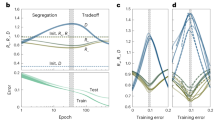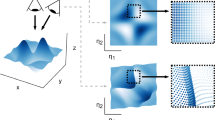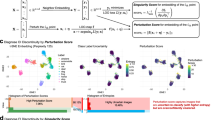Abstract
As a pivotal branch of machine learning, manifold learning uncovers the intrinsic low-dimensional structure within complex non-linear manifolds in high-dimensional space for visualization, classification, clustering and gaining key insights. Although existing techniques have achieved remarkable successes, they suffer from extensive distortions of cluster structure, which hinders the understanding of underlying patterns. Scalability issues also limit their applicability for handling large-scale data. Here we propose a sampling-based scalable manifold learning technique that enables uniform and discriminative embedding (SUDE) for large-scale and high-dimensional data. It starts by seeking a set of landmarks to construct the low-dimensional skeleton of the entire data and then incorporates the non-landmarks into the learned space by constrained locally linear embedding. We empirically validated the effectiveness of SUDE on synthetic datasets and real-world benchmarks and applied it to analyse single-cell data and detect anomalies in electrocardiogram signals. SUDE exhibits a distinct advantage in scalability with respect to data size and embedding dimension and shows promising performance in cluster separation, integrity and global structure preservation. The experiments also demonstrate notable robustness in embedding quality as the sampling rate decreases.
This is a preview of subscription content, access via your institution
Access options
Access Nature and 54 other Nature Portfolio journals
Get Nature+, our best-value online-access subscription
$32.99 / 30 days
cancel any time
Subscribe to this journal
Receive 12 digital issues and online access to articles
$119.00 per year
only $9.92 per issue
Buy this article
- Purchase on SpringerLink
- Instant access to full article PDF
Prices may be subject to local taxes which are calculated during checkout






Similar content being viewed by others
Data availability
The real-world datasets used in this study are available as follows: Wine via University of California Irvine at http://archive.ics.uci.edu/dataset/109/wine, Dermatology via University of California Irvine at http://archive.ics.uci.edu/dataset/33/dermatology, Breast-Cancer via National Taiwan Univeristy at https://www.csie.ntu.edu.tw/~cjlin/libsvmtools/datasets/binary/breast-cancer, Mfeat via University of California Irvine at https://archive.ics.uci.edu/dataset/72/multiple+features, Rice via University of California Irvine at https://archive.ics.uci.edu/dataset/545/rice+cammeo+and+osmancik, Spambase via University of California Irvine at https://archive.ics.uci.edu/dataset/94/spambase, Dry-Bean via University of California Irvine at https://archive.ics.uci.edu/dataset/602/dry+bean+dataset, Shuttle via University of California Irvine at https://archive.ics.uci.edu/dataset/148/statlog+shuttle, CIFAR10 via the University of Toronto at https://www.cs.toronto.edu/~kriz/cifar.html, MNIST via Yann LeCun at https://yann.lecun.com/exdb/mnist/, FMNIST via Github at https://github.com/zalandoresearch/fashion-mnist, AG’s News via the University of Pisa at http://www.di.unipi.it/~gulli/AG_corpus_of_news_articles.html, Yahoo via GitHub at https://github.com/zjulearning/AtSNE, WT via the GEO database with accession no. GSE125708, HRPEAC via the Broad Institute at https://singlecell.broadinstitute.org/single_cell/study/SCP3025/scrna-seq-and-scatac-seq-atlas-of-human-retinal-pigment-epithelium-and-choroid?#study-download), SARS-CoV-2 via the Broad Institute at https://singlecell.broadinstitute.org/single_cell/study/SCP2593/impact-of-variants-and-vaccination-on-nasal-immunity-across-three-waves-of-sars-cov-2#study-download, Levine via FlowRepository with accession no. FR-FCM-ZZPH, QT database via Mathworks at https://www.mathworks.com/supportfiles/SPT/data/QTDatabaseECGData.zip and MIT-BIH long-term database via PhysioNet at https://archive.physionet.org/physiobank/database/ltdb/.
Code availability
The source code for SUDE in MATLAB and Python versions is available via GitHub at https://github.com/ZPGuiGroupWhu/sude (ref. 74) and via Code Ocean at https://doi.org/10.24433/CO.9866909.v3 (ref. 75). The TriMap algorithm is available via OMIQ at http://www.omiq.ai. The Seurat software is available via the Satija Lab at https://satijalab.org/seurat. The TopoAE model is available via GitHub at https://github.com/BorgwardtLab/topological-autoencoders. The P-UMAP model is available via Read the Docs at https://umap-learn.readthedocs.io/en/latest/parametric_umap.html. The Slingshot toolkit is available via GitHub at https://github.com/kstreet13/slingshot.
References
Busch, E. L. et al. Multi-view manifold learning of human brain-state trajectories. Nat. Comput. Sci. 3, 240–253 (2023).
Floryan, D. & Graham, M. D. Data-driven discovery of intrinsic dynamics. Nat. Mach. Intell. 4, 1113–1120 (2022).
Islam, M. T. et al. Revealing hidden patterns in deep neural network feature space continuum via manifold learning. Nat. Commun. 14, 8506 (2023).
Vogelstein, J. T. et al. Supervised dimensionality reduction for big data. Nat. Commun. 12, 2872 (2021).
Hotelling, H. Analysis of a complex of statistical variables into principal components. J. Educ. Psychol. 25, 417–441 (1933).
Peng, D., Gui, Z., Gui, J., & Wu, H. A robust and efficient boundary point detection method by measuring local direction dispersion. IEEE Trans. Circuits Syst. Video Technol. https://doi.org/10.1109/TCSVT.2025.3546401 (2025).
Kruskal, J. B. Multidimensional scaling by optimizing goodness of fit to a nonmetric hypothesis. Psychometrika 29, 1–27 (1964).
Fisher, R. A. The use of multiple measurements in taxonomic problems. Ann. Eugenics 7, 179–188 (1936).
Yan, S. et al. Nonlinear discriminant analysis on embedded manifold. IEEE Trans. Circuits Syst. Video Technol. 17, 468–477 (2007).
Zhang, L., Zhou, W. & Chang, P.-C. Generalized nonlinear discriminant analysis and its small sample size problems. Neurocomputing 74, 568–574 (2011).
Tenenbaum, J. B., Silva, V. D. & Langford, J. C. A global geometric framework for nonlinear dimensionality reduction. Science 290, 2319–2323 (2000).
Roweis, S. T. & Saul, L. K. Nonlinear dimensionality reduction by locally linear embedding. Science 290, 2323–2326 (2000).
Cover, T. & Hart, P. Nearest neighbor pattern classification. IEEE Trans. Inf. Theory 13, 21–27 (1967).
Belkin, M., & Niyogi, P. Laplacian eigenmaps and spectral techniques for embedding and clustering. In Proc. Advanced Neural Information Processing Systems (eds Dietterich, T. G. et al.) 585–591 (2001).
Donoho, D. L. & Grimes, C. Hessian eigenmaps: Locally linear embedding techniques for high-dimensional data. Proc. Natl Acad. Sci. USA 100, 5591–5596 (2003).
Coifman, R. R. et al. Geometric diffusions as a tool for harmonic analysis and structure definition of data: diffusion maps. Proc. Natl Acad. Sci. USA 102, 7426–7431 (2005).
van der Maaten, L. & Hinton, G. Visualizing data using t-SNE. J. Mach. Learn. Res. 9, 2579–2605 (2008).
McInnes, L., Healy, J., Saul, N. & Groçberger, L. UMAP: uniform manifold approximation and projection. J. Open Source Softw. 3, 861 (2018).
Becht, E. et al. Dimensionality reduction for visualizing single-cell data using UMAP. Nat. Biotechnol. 37, 38–44 (2019).
Amid, E. & Warmuth, M. K. TriMap: large-scale dimensionality reduction using triplets. Preprint at https://arxiv.org/abs/1910.00204 (2022).
Fu, C., Zhang, Y., Cai, D. & Ren, X. AtSNE: efficient and robust visualization on GPU through hierarchical optimization. In Proc. 25th ACM SIGKDD International Conference on Knowledge Discovery and Data Mining (KDD) 176–186 (Association for Computing Machinery, 2019).
Moon, K. R. et al. Visualizing structure and transitions in high-dimensional biological data. Nat. Biotechnol. 37, 1482–1492 (2019).
Kobak, D. & Berens, P. The art of using t-SNE for single-cell transcriptomics. Nat. Commun. 10, 5416 (2019).
Shen, C. & Wu, H.-T. Scalability and robustness of spectral embedding: landmark diffusion is all you need. Inf. Inference 11, 1527–1595 (2022).
Long, A. W. & Ferguson, A. L. Landmark diffusion maps (L-dMaps): accelerated manifold learning out-of-sample extension. Appl. Comput. Harmon. Anal. 47, 190–211 (2019).
Persad, S. et al. SEACells infers transcriptional and epigenomic cellular states from single-cell genomics data. Nat. Biotechnol. 41, 1746–1757 (2023).
Stanoi, I., Riedewald, M., Agrawal, D. & El Abbadi, A. Discovery of influence sets in frequently updated databases. In Proc. 27th International Conference on Very Large Databases (VLDB) (eds. Apers P. M. G. et al.) 99–108 (Morgan Kaufmann Publishers Inc., 2001).
Tao, Y., Papadias, D. & Lian, X. Reverse kNN search in arbitrary dimensionality. In Proc. 30th International Conference on Very Large Databases (VLDB) (eds Nascimento, M. A. et al.) 744–755 (Morgan Kaufmann Publishers Inc., 2004).
Radovanovic, M., Nanopoulos, A. & Ivanovic, M. Hubs in space: popular nearest neighbors in high-dimensional data. J. Mach. Learn. Res. 11, 2487–2531 (2010).
Loshchilov, I. & Hutter, F. SGDR: stochastic gradient descent with warm restarts. In Proc. 5th International Conference on Learning Representations (ICLR) 1769–1784 (Curran Associates, 2017).
Peng, D., Gui, Z. & Wu, H. MeanCut: a greedy-optimized graph clustering via path-based similarity and degree descent criterion. Preprint at https://arxiv.org/abs/2312.04067 (2023).
Karypis, G., Han, E.-H. & Kumar, V. Chameleon: hierarchical clustering using dynamic modeling. Computer 32, 68–75 (1999).
France, S. & Carroll, D. in Machine Learning and Data Mining in Pattern Recognition (ed. Perner, P.) vol. 4,571, 499–517 (2007).
Moor, M., Horn, M., Rieck, B. & Borgwardt, K. Topological autoencoders. In Proc. 37th International Conference on Machine Learning (ICML) (eds Daumé, H. & Singh, A.) 7045–7054 (PMLR, 2020).
Sainburg, T., McInnes, L. & Gentner, T. Q. Parametric UMAP embeddings for representation and semisupervised learning. Neural Comput. 33, 2881–2907 (2021).
Dua, D. & Graff, C. UCI machine learning repository. University of California Irvine https://archive.ics.uci.edu (2019).
Krizhevsky, A. & Hinton, G. Learning Multiple Layers of Features from Tiny Images Technical Report (Univ. Toronto, 2009).
Lecun, Y., Bottou, L., Bengio, Y. & Haffner, P. Gradient-based learning applied to document recognition. Proc. IEEE 86, 2278–2324 (1998).
Xiao, H., Rasul, K. & Vollgraf, R. Fashion-MNIST: a novel image dataset for benchmarking machine learning algorithms. Preprint at https://arxiv.org/abs/1708.07747 (2017).
Corso, G. M. D., Gulli, A. & Romani, F. Ranking a stream of news. In Proc. 14th International World Wide Web Conference (WWW) 97–106 (Association for Computing Machinery, 2005).
Poličar, P. G., Stražar, M. & Zupan, B. openTSNE: a modular Python library for t-SNE dimensionality reduction and embedding. J. Stat. Softw. 109, 1–30 (2024).
Huang, H., Wang, Y., Rudin, C. & Browne, E. P. Towards a comprehensive evaluation of dimension reduction methods for transcriptomic data visualization. Commun. Biol. 5, 719 (2022).
Amir, E. A. et al. viSNE enables visualization of high dimensional single-cell data and reveals phenotypic heterogeneity of leukemia. Nat. Biotechnol. 31, 545–552 (2013).
Khan, S. A. et al. Reusability report: learning the transcriptional grammar in single-cell RNA-sequencing data using transformers. Nat. Mach. Intell. 5, 1437–1446 (2023).
Heng, J. S. et al. Hypoxia tolerance in the Norrin-deficient retina and the chronically hypoxic brain studied at single-cell resolution. Proc. Natl Acad. Sci. USA 116, 9103–9114 (2019).
Satija, R. et al. Spatial reconstruction of single-cell gene expression data. Nat. Biotechnol. 33, 495–502 (2015).
Kiselev, V. Y., Andrews, T. S. & Hemberg, M. Challenges in unsupervised clustering of single-cell RNA-seq data. Nat. Rev. Genet. 20, 273–282 (2019).
Peng, D. et al. Clustering by measuring local direction centrality for data with heterogeneous density and weak connectivity. Nat. Commun. 13, 5455 (2022).
Wang, S. K. et al. Single-cell multiome and enhancer connectome of human retinal pigment epithelium and choroid nominate pathogenic variants in age-related macular degeneration. Preprint at bioRxiv https://doi.org/10.1101/2025.03.21.644670 (2025).
Ziegler, C. G. et al. Impaired local intrinsic immunity to SARS-CoV-2 infection in severe COVID-19. Cell 184, 4713–4733 (2021).
Levine, J. H. et al. Data-driven phenotypic dissection of AML reveals progenitor-like cells that correlate with prognosis. Cell 162, 184–197 (2015).
Weber, L. M. & Robinson, M. D. Comparison of clustering methods for high-dimensional single-cell flow and mass cytometry data. Cytom. A 89, 1084–1096 (2016).
Ferrari, G., Thrasher, A. J. & Aiuti, A. Gene therapy using haematopoietic stem and progenitor cells. Nat. Rev. Genet. 22, 216–234 (2021).
Street, K. et al. Slingshot: cell lineage and pseudotime inference for single-cell transcriptomics. BMC Genomics 19, 477 (2018).
Trapnell, C. et al. The dynamics and regulators of cell fate decisions are revealed by pseudotemporal ordering of single cells. Nat. Biotechnol. 32, 381–386 (2014).
Young, W. J. et al. Genetic analyses of the electrocardiographic QT interval and its components identify additional loci and pathways. Nat. Commun. 13, 5144 (2022).
Niroshana, S. M. I., Kuroda, S., Tanaka, K. & Chen, W. Beat-wise segmentation of electrocardiogram using adaptive windowing and deep neural network. Sci. Rep. 13, 11039 (2023).
Huo, R. et al. ECG segmentation algorithm based on bidirectional hidden semi-Markov model. Comput. Biol. Med. 150, 106081 (2022).
Oberlin, T., Meignen, S. & Perrier, V. The Fourier-based synchrosqueezing transform. In Proc. IEEE International Conference on Acoustics, Speech and Signal Processing (ICASSP) 315–319 (IEEE, 2014).
Hochreiter, S. & Schmidhuber, J. Long short-term memory. Neural Comput. 9, 1735–1780 (1997).
Laguna, P., Mark, R. G., Goldberg, A. & Moody, G. B. A database for evaluation of algorithms for measurement of QT and other waveform intervals in the ECG. Comput. Cardiol. 24, 673–676 (1997).
Goldberger, A. L. et al. PhysioBank, PhysioToolkit, and PhysioNet: components of a new research resource for complex physiologic signals. Circulation 101, e215–e220 (2000).
Bengio, Y., Courville, A. & Vincent, P. Representation learning: a review and new perspectives. IEEE Trans. Pattern Anal. Mach. Intell. 35, 1798–1828 (2013).
Peng, D., Gui, Z. & Wu, H. Interpreting the curse of dimensionality from distance concentration and manifold effect. Preprint at https://arxiv.org/abs/2401.00422 (2023).
Healy, J. & McInnes, L. Uniform manifold approximation and projection. Nat. Rev. Methods Primers 4, 82 (2024).
Malkov, Y. A. & Yashunin, D. A. Efficient and robust approximate nearest neighbor search using hierarchical navigable small world graphs. IEEE Trans. Pattern Anal. Mach. Intell. 42, 824–836 (2018).
Dong, W., Moses, C. & Li, K. Efficient k-nearest neighbor graph construction for generic similarity measures. In Proc. 20th International Conference on World Wide Web (WWW) 577–586 (Association for Computing Machinery, 2011).
Saul, L. K. & Roweis, S. T. Think globally, fit locally: unsupervised learning of low dimensional manifolds. J. Mach. Learn. Res. 4, 119–155 (2003).
Wang, J. Real local-linearity preserving embedding. Neurocomputing 136, 7–13 (2014).
Wang, Z. et al. Clustering by local gravitation. IEEE Trans. Cybern. 48, 1383–1396 (2018).
von Luxburg, U. A tutorial on spectral clustering. Stat. Comp. 17, 395–416 (2007).
Ding, J., Shah, S. & Condon, A. densityCut: an efficient and versatile topological approach for automatic clustering of biological data. Bioinformatics 32, 2567–2576 (2016).
Kuhn, H. W. The Hungarian method for the assignment problem. Nav. Res. Logist. Q. 2, 83–97 (1955).
Peng, D. Source code of SUDE. Zenodo https://doi.org/10.5281/zenodo.16792257 (2025).
Peng, D. Open code for in-review “Sampling-enabled scalable manifold learning unveils discriminative cluster structure of high-dimensional data”. Code Ocean https://doi.org/10.24433/CO.9866909.v3 (2025).
Acknowledgements
We thank Y. Tang and Z. Ruan for technical assistance in the analysis of single-cell data. We are also grateful to Y. Liu and R. Wang for language and technical discussion. This paper is supported by the National Natural Science Foundation of China (grant nos. 42090011, 42501573, 42571496, 41971349 and 41930107), Postdoctoral Fellowship Program and China Postdoctoral Science Foundation (grant no. BX20250084), China Postdoctoral Science Foundation (grant no. 2025M770345) and Fundamental Research Funds for the Central Universities (grant nos. 2042024kf0005 and 2042025kf0084).
Author information
Authors and Affiliations
Contributions
Z.G., H.W. and J. Gong envisioned the study. D.P. and Z.G. designed the algorithm and collected datasets. D.P., W.W. and Z.G. conducted experiments and performed the analysis. D.P., Z.G., W.W. and F.L. wrote the manuscript. H.W. and J. Gui provided advice in analysis.
Corresponding author
Ethics declarations
Competing interests
The authors declare no competing interests.
Peer review
Peer review information
Nature Machine Intelligence thanks Dmitry Kobak, Samantha Riesenfeld, Ryan Robinett and the other, anonymous, reviewer(s) for their contribution to the peer review of this work.
Additional information
Publisher’s note Springer Nature remains neutral with regard to jurisdictional claims in published maps and institutional affiliations.
Supplementary information
Supplementary Information
Supplementary Notes 1–12, Figs. 1–31 and Tables 1–4.
Rights and permissions
Springer Nature or its licensor (e.g. a society or other partner) holds exclusive rights to this article under a publishing agreement with the author(s) or other rightsholder(s); author self-archiving of the accepted manuscript version of this article is solely governed by the terms of such publishing agreement and applicable law.
About this article
Cite this article
Peng, D., Gui, Z., Wei, W. et al. Sampling-enabled scalable manifold learning unveils the discriminative cluster structure of high-dimensional data. Nat Mach Intell (2025). https://doi.org/10.1038/s42256-025-01112-9
Received:
Accepted:
Published:
DOI: https://doi.org/10.1038/s42256-025-01112-9



